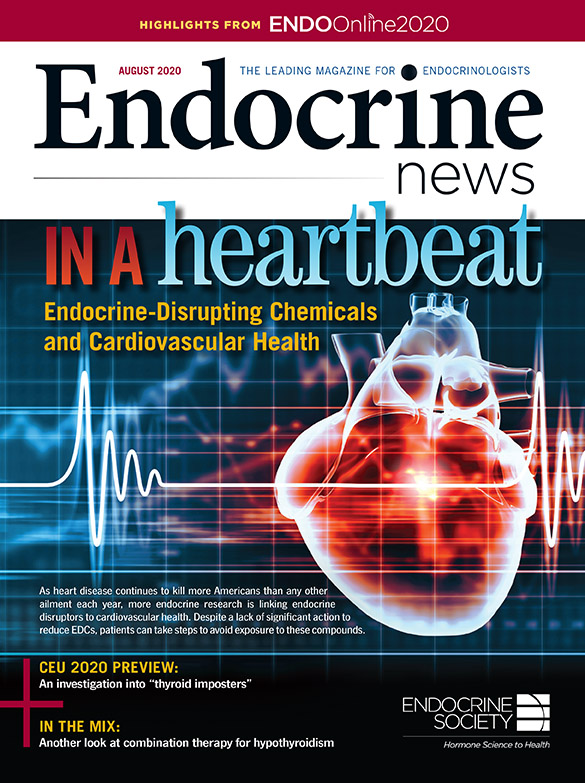A first-of-its-kind Endocrine Society clinical practice guideline recommends lipid profiles and cardiovascular risk assessment for patients with endocrine disorders. Pay more attention to lipids and cardiovascular risk when you are treating people with endocrine diseases. That is the plea from the new publication, “Lipid Management in Patients with Endocrine Disorders: An Endocrine Society Clinical...
Eureka 2020! Part I – Top Endocrine Science According to Endocrinology Editors
 For the sixth year running, Endocrine News talks to editors from Endocrine Society publications to get the scoop on the top endocrine discoveries of 2020. In this first installment, we talk to Endocrinology editors about what they think this year’s most significant studies were that will impact endocrine science for years to come. Despite the...
For the sixth year running, Endocrine News talks to editors from Endocrine Society publications to get the scoop on the top endocrine discoveries of 2020. In this first installment, we talk to Endocrinology editors about what they think this year’s most significant studies were that will impact endocrine science for years to come. Despite the...Adults with Endocrine Disorders Have Increased Risk of Heart Disease
Endocrine Society’s latest Clinical Practice Guideline includes cholesterol management recommendations for thyroid disease, menopause, and more. All adults with endocrine disorders should be tested for high cholesterol and triglycerides to evaluate their risk of heart attack or stroke, according to a Clinical Practice Guideline issued today by the Endocrine Society. The guideline, titled “Lipid Management...
Veiled Threats: New Findings Show More Links Between EDCs and Cardiovascular Health
 As heart disease continues to kill more people than any other ailment annually, more endocrine research is linking endocrine disruptors to cardiovascular health. Patients can reduce their own exposure to these compounds. Cardiovascular disease (CVD) is the leading cause of mortality in the U.S., responsible for a quarter of all deaths, with someone succumbing to...
As heart disease continues to kill more people than any other ailment annually, more endocrine research is linking endocrine disruptors to cardiovascular health. Patients can reduce their own exposure to these compounds. Cardiovascular disease (CVD) is the leading cause of mortality in the U.S., responsible for a quarter of all deaths, with someone succumbing to...Heart Attack, Stroke Risk Declines among People with Diabetes
Two-decade study shows overall mortality risk remains higher than general population The rate of heart attacks, strokes and other cardiovascular complications has improved among people with diabetes over the past 20 years, narrowing the gap in cardiovascular mortality rates between individuals with and without diabetes, according to a new study published in The Journal of Clinical...
New data highlights how cold exposure activates brown fat, energy metabolism Short-term cold exposure may help people with brown fat burn 15 percent more calories than those without, according to a small study published in The Journal of Clinical Endocrinology & Metabolism. Unlike white fat, brown fat burns calories through fatty acid oxidation and heat production and is considered a promising target in the fight against the obesity epidemic. The biggest activator of brown fat is moderate cold exposure. “This data improves our understanding of how brown fat works...
Studies linking statins to diabetes receive media attention but should not distract clinicians from the goal of reducing cardiovascular risk. Almost eight years after the Food and Drug Administration (FDA) added a warning to statin labels about the drugs increasing fasting blood sugar and hemoglobin A1C levels — and by inference raising the risk of...
 Endocrine News talks with James Rosenzweig, MD, chair of the task force that developed the latest Endocrine Society Clinical Practice Guideline on Preventing Cardiovascular Disease and Type 2 Diabetes in Patients at Metabolic Risk. A new Endocrine Society clinical practice guideline states that measuring waistline, blood pressure, cholesterol, and blood sugar during doctor’s visits could...
Endocrine News talks with James Rosenzweig, MD, chair of the task force that developed the latest Endocrine Society Clinical Practice Guideline on Preventing Cardiovascular Disease and Type 2 Diabetes in Patients at Metabolic Risk. A new Endocrine Society clinical practice guideline states that measuring waistline, blood pressure, cholesterol, and blood sugar during doctor’s visits could...
